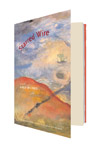You can find manic invention, non-Euclidean dreamlike verbal spaces, acrobatic attempts to get around and above ordinary prose syntax, “secret arts acquired in cloven pine prisons,” in a double handful of exciting youngish poets. And you can find in an equal number some wry observations on modern urban life. It’s harder—and better—to find those virtues together, to find both the conjuring spirit’s vigor and the realist trickster’s charm. Ange Mlinko’s second book offers both.
Mlinko’s first collection, Matinees, portrayed her as the product of one place and time: Northeast Corridor America in the late-indie-rock era, with a faux-slapdash, sociable concentration very, very close to Frank O’Hara’s. Starred Wire also depicts friends, painters and rock-and-rollers, cool sites and zeitgeists: Mlinko muses on why we like botanical gardens, on how “exposed pipes that could pass / for clothes poles” become minor dangers for apartment dwellers, on what makes a museum in Brooklyn or Paris dull or fun.
Yet the world this second book inhabits extends beyond subways and clublands, far beyond “girls with the black frame glasses and white wings,” into a kind of imagined aerial realm, a Technicolor urbane pastoral, bigger and stranger than what we see with unaided eyes. A poem called “Romance” recommends “unmolding the thoughts we bore the brunt of / in order to exaggerate into paradise / displacing pages toward the shore.” Trying to improve on the visible realm, Mlinko attempts “a sort of divination, / lying down conjuring the Fred and Ginger building // so to pollinate my categories like catbirds and cowbirds.”
Mlinko’s line and stanza (like O’Hara’s) emphasize exuberance, expansion, speed. Her sensibility, however, gives equal weight to the diminutively curious: she casts herself as a patroller and omnivore, half John Ashbery, half Harriet the Spy: “A comprehensive view of the environs, through a crooked part, / is the shy girl’s cunning,” she explains. Sometimes she’s influenced by Victorian “nonsense,” asking how the unlimited inventions of childhood can salve, if not solve, adult concerns: “Insert the cherries in the earth, / read the manual for escapes, / sunscreen under the pillow, / rain scratching glasses,” she advises in “Outwitting Boy Scouts.” In her worst moments she’s simply producing nonsense— but such are the risks inventors take; in her best she offers reasons to feel happy, or apprehensive, or expectant. Even “the evening / has a beginning,” she promises, “there’s a whole museum to it / hidden in the park.”
Starred Wire comes out of a decidedly downtown, evasive, anti-prose-sense tradition: it’s hardly abstract, but it’s not often narrative either. The more time I spend with the book, though, the more I can see hints at an autobiography. “Even collage has an organizing principle to skirt,” “Boston Flower Market” notes. Sprinting and doubling through screens of art-school argot, mazes of Euro-classical allusions, and ladders of New York Times terms, Mlinko is also writing down the life of an economically anxious, information-rich, malleable, volatile generation. “Never mind the student loans that went for poetry, reimbursing itself with itself,” she instructs: “When curves of supply rose from the banquette, you were the cause of yourself, not the correlation or the echo of the forms that hugged themselves to end; but broke the surface, like an interdisciplinary dolphin.”





